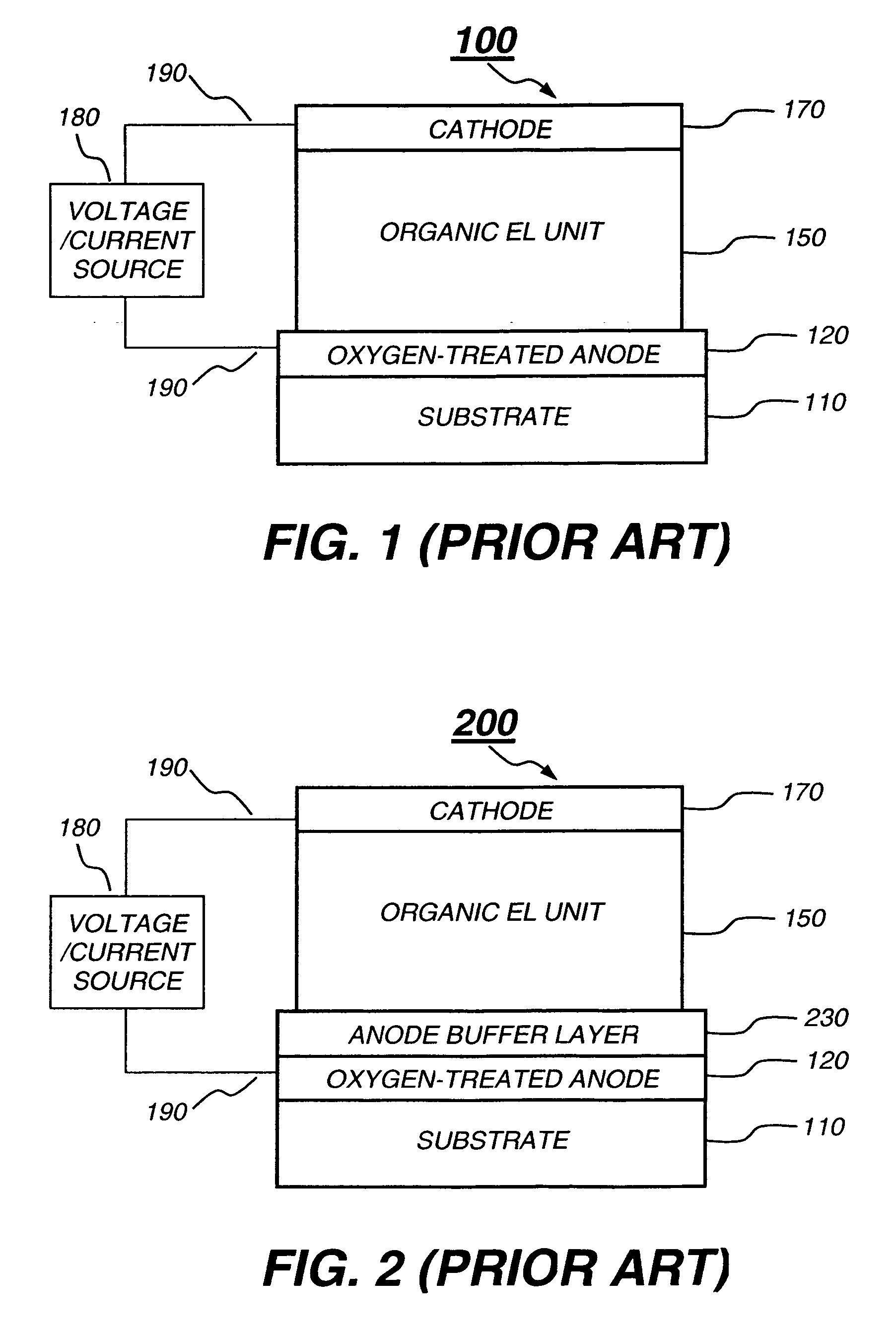OLED anode modification layer
a technology of anode modification and anode layer, which is applied in the direction of thermoelectric devices, discharge tube luminescnet screens, natural mineral layered products, etc., can solve the problems of high drive voltage, low operational life, and inability to effectively use anode as a prepared or clean on
- Summary
- Abstract
- Description
- Claims
- Application Information
AI Technical Summary
Benefits of technology
Problems solved by technology
Method used
Image
Examples
example 3 (
Inventive)
[0135] An OLED in accordance with the present invention was constructed as the same as that in Example 1, except that an anode modification layer with 0.2-nm-thick F4-TCNQ was subsequently deposited on the non-oxygen-treated ITO surface before the deposition of the organic EL unit. The reduction potential of F4-TCNQ was measured as about 0.64 V vs. SCE in the 1:1 MeCN / MePh organic solvent system.
[0136] This OLED, having an anode modification layer in direct contact with the non-oxygen-treated anode, requires a drive voltage of about 4.9 V to pass 20 mA / cm2. Under this test condition, the device has a luminance of 1933 cd / m2, and a luminous efficiency of about 9.7 cd / A. Its emission peak is at 520 nm. The operational lifetime, measured as T50(RT@80 mA / cm2), is about 320 hours (Just for a convenient comparison, it is worthwhile to know that if this device were operated at room temperature and at 20 mA / cm2, its operational lifetime would be at least 6 time longer, i.e. its T...
example 7 (
Inventive)
[0150] An OLED, having an anode modification layer in direct contact with a non-oxygen-treated anode, was constructed in accordance with the present invention. This OLED is the same as that in Example 4, except that 1) a layer of hexanitrile hexaazatriphenylene, 10 nm thick, was deposited on the non-oxygen-treated ITO surface as the anode modification layer, and 2) the thickness of the HTL (NPB layer) in the organic EL unit was reduced from 75 nm to 65 nm.
[0151] This OLED requires a drive voltage of about 6.2 V to pass 20 mA / cm2. Under this test condition, the device has a luminance of 1703 cd / m2, and a luminous efficiency of about 8.5 cd / A. Its emission peak is at 520 nm. The operational lifetime, measured as T50(RT@80 mA / cm2), is about 188 hours. Its luminance vs. operational time and its drive voltage vs. operational time, tested at room temperature and at 80 mA / cm2, are shown in FIGS. 12 and 13, respectively.
example 9 (
Inventive)
[0155] An OLED, having an anode modification layer in direct contact with a non-oxygen-treated anode, was constructed in accordance with the present invention. This OLED is the same as that in Example 7 and was used for high temperature test.
[0156] This OLED requires a drive voltage of about 6.3 V to pass 20 mA / cm2. Under this test condition, the device has a luminance of 1755 cd / m2, and a luminous efficiency of about 8.8 cd / A. Its emission peak is at 520 nm. The operational lifetime, measured as T50(85° C.@80 mA / cm2), is about 12 hours. Its luminance vs. operational time and its drive voltage vs. operational time, tested at 85° C. and at 80 mA / cm2, are shown in FIGS. 14 and 15, respectively.
PUM
| Property | Measurement | Unit |
|---|---|---|
| Thickness | aaaaa | aaaaa |
| Thickness | aaaaa | aaaaa |
| Electric potential / voltage | aaaaa | aaaaa |
Abstract
Description
Claims
Application Information
 Login to View More
Login to View More - R&D
- Intellectual Property
- Life Sciences
- Materials
- Tech Scout
- Unparalleled Data Quality
- Higher Quality Content
- 60% Fewer Hallucinations
Browse by: Latest US Patents, China's latest patents, Technical Efficacy Thesaurus, Application Domain, Technology Topic, Popular Technical Reports.
© 2025 PatSnap. All rights reserved.Legal|Privacy policy|Modern Slavery Act Transparency Statement|Sitemap|About US| Contact US: help@patsnap.com



